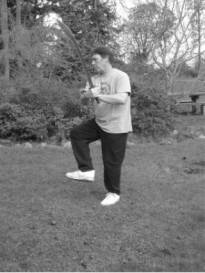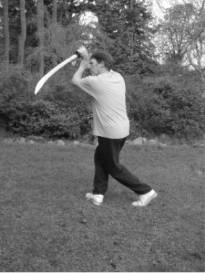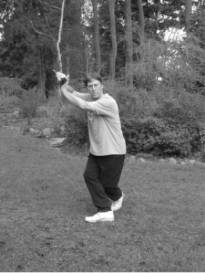 Gilman Studio On-Line Lessons
Gilman Studio On-Line Lessons
Yang Style
Tai Chi Dao/Saber/Broadsword
This Lesson Contains:
Movement # 32 – Left And Right Double Wheel
Wow! A huge movement – 45 pictures, It always seemed to me that this should have been two movements, not one, since it really consists of two separate movements that are quite similar. Following Retreat and Parry to the Left, I step inside and slash across the opponent’s chest. She falls back and I follow her, attacking with an upper cut. Part two is basically a repeat. She pokes, I neutralize, step inside, and this time I press upward. She again retreats; I follow, and deliver an upper cut. It is important to make all this one, smooth movement. When done smoothly, there are two large wheels or circles drawn on both sides of the body.
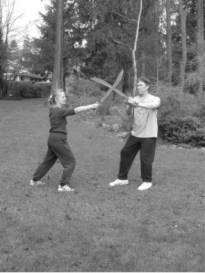
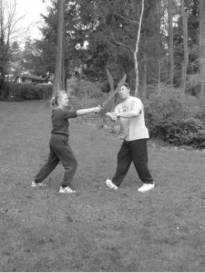 1) Stephie poked and I retreated and Parried to the Left.
1) Stephie poked and I retreated and Parried to the Left.
2) Sticking, I start to move inside.
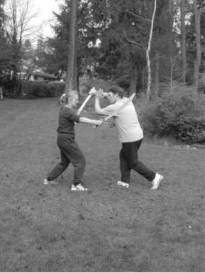
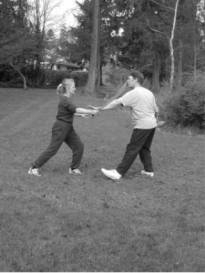 1) I slash across her upper body.
1) I slash across her upper body.
2) She evaded my slash and stepped back. I follow and attach to her saber hand.

 1) She continues to retreat and I follow.
1) She continues to retreat and I follow.
2) I upper cut to her lower body.
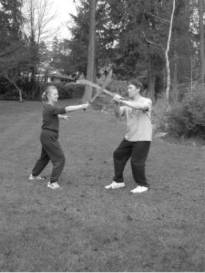
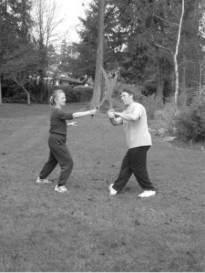 1) She pokes to my upper body and I join, stick and lead her to the left.
1) She pokes to my upper body and I join, stick and lead her to the left.
2) Sticking I start to move inside.

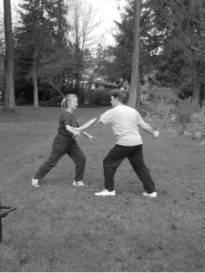 1) I press upward to her center.
1) I press upward to her center.
2) She evades and retreats. I follow.
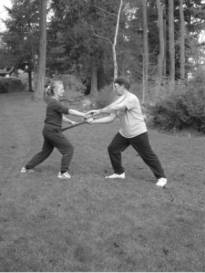 I use an upper cut to her lower body.
I use an upper cut to her lower body.
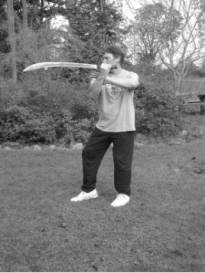
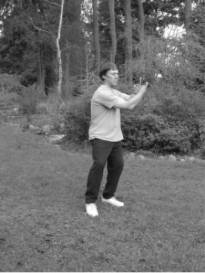 The end of Retreat And Parry to the Left.
The end of Retreat And Parry to the Left.
Lift up the right foot and rotate out the hip so the toe turns to the right.
The saber is starting a clockwise circle on the left side of the body. The left hand sticks to the right wrist.
Focus on the outside of the saber blade for sticking.
Note: You have to be careful to stick when moving in for the slash. You are quite vulnerable if you don’t.
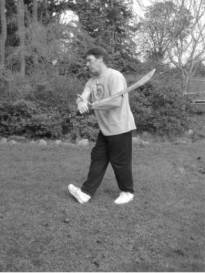
 Stepping inside and starting the slash.
Stepping inside and starting the slash.
Touch down the right heel. The toe faces halfway between east and south. The weight starts to shift onto the right foot.
The saber continues its circle and is being drawn down and slightly to the right.
Focus on the target, and keep some awareness on the opponent’s saber.
Shift the weight onto the right foot and roll up onto the left toe. The torso is turning to the right as the weight is shifted.
The hands are pulled across the body and upward to end by the right side of the head. The sharp cutting edge of your saber is diagonally across the front of your upper body with the point slightly forward of the handle.
Focus on the cutting edge.
Note: This is a very strong slash since the whole body and the arms are pulling the saber across the body.
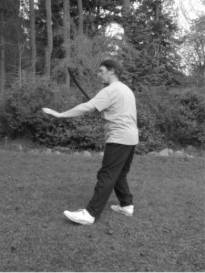
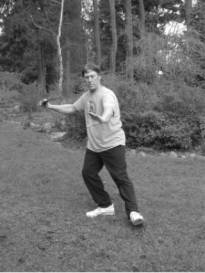 The opponent falls back and I attach and follow.
The opponent falls back and I attach and follow.
Sink the weight into the right Kua and step ahead with the left foot, touching down just the heel. The toe faces slightly to the left of east.
The left hand reaches out to the front of the middle of the chest as if to grab the opponent’s wrist.
The saber now starts to circle in the opposite direction to swing up and forward on the right side of the body.
Focus on attaching with the left palm.
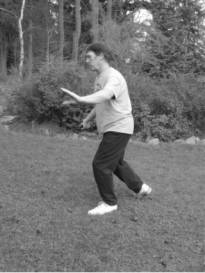
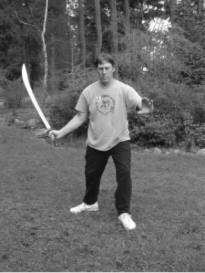 Following the withdrawal of the opponent and continuing the attack with the saber.
Following the withdrawal of the opponent and continuing the attack with the saber.
The left foot rotates out so the toe faces halfway between east and north. Shift the weight onto the left foot and roll up onto the right toe.
The saber continues its swing up and to the front.
Focus on the target.
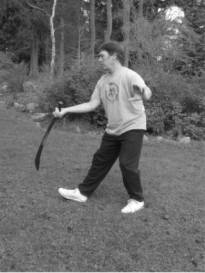
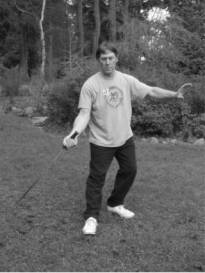 Continuing the follow and attack.
Continuing the follow and attack.
Step forward with the right foot, touching down the heel. The toe faces east.
The saber continues its upward swing and starts to angle toward the center.
Focus on the target.
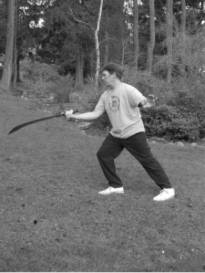
 The upper cut (and first wheel) is complete.
The upper cut (and first wheel) is complete.
Shift the weight onto the right foot until the knee covers the toe. The torso has turned slightly more to the left in order to get good torque release for the upper cut.
The left hand has pulled around to the rear, facing outward to balance the forward cutting of the saber.
The saber cutting edge ends in the front of the lower body with the sharp edge upward. Notice that the right hand is slightly to the right of the point. If you have the hand and the point on the same vertical plane there will be too much strain on the forearm.
Focus on the cutting edge.

 A repeat of Retreat and Parry to the Left, only not named as a separate movement.
A repeat of Retreat and Parry to the Left, only not named as a separate movement.
Turning the torso to the left, pull in the right foot to empty stance on toe.
The saber is drawn up to the left and the hand rotates clockwise to turn the flat of the blade outward to neutralize and stick. The rotation happens as the hand moves up to the left.
The left hand moves to attach to the right wrist to support the saber.
Focus on the flat of the blade for joining, sticking and leading.
 Starting to step in while sticking.
Starting to step in while sticking.
A repeat of the previous step in. Lift up the right foot and rotate out the hip. The saber starts its circle.
Focus on sticking.
For this movement, place down the right foot so the toe faces south. This is more to the right then it was last time because we are going to squat lower.
The left hand leaves the right wrist and is getting ready to press upward by moving near the middle of the saber blade.
Focus on the saber blade for sticking and moving inside.
Shift the weight onto the right leg and squat down until the left leg almost touches the ground near the right heel. The torso has turned to the right. Be sure you have stepped far enough to the front with the right foot so there is room for this squat down move. If you lack flexibility, you do not have to squat as low as this.
The two hands combine to make this a strong upward press. The heel of the left palm is placed on the rear of the saber blade about three quarters of the way down toward the point. The hands are over the top of the head with the right palm near the right temple. The two hands have made a diagonal arc from bottom left to upper right.
Focus on the cutting edge of the blade.

 I follow and start my upper cut.
I follow and start my upper cut.
Start to step forward by coming up out of the deep stance and sink the weight onto the right Kua.
The left hand reaches forward at the center of the chest level with the palm out, as if grabbing. The saber is going to make a large swing motion on the right side of the body again.
Focus on the left hand for joining.
Step forward with the left foot, just touching down the heel. The toe is going to end up facing halfway between east and north.
The hands stay in the same basic relationship to the body – the left is joined and leading to the left, while the right swings the saber forward.
Focus on leading with the left and the possible target.
Shift the weight onto the left foot with the toe turned out to the left halfway between north and east. The torso is turning to the left.
The left hand continues to lead to the left and the right continues to swing the saber forward and up.
Focus on the leading and the target.
Step forward with the right foot, touching down the heel. The toe faces east. The torso has turned a bit more to the left.
The left hand continues to lead to the left and is now back by the right leg at chest height.
The right hand is in front and the tip of the saber is starting to swing upward toward the center.
Focus on the target.
Shift the weight completely onto the right foot until the knee just covers the toe. The toe and knee face east. The torso is facing slightly to the left. Be careful not to overextend or lean.
The left hand is held behind the body in line with the left leg at chest level.
The saber point is directed toward the front and lower center of the body. Notice that the right hand is held slightly to the right of the point in order not to stress out the forearm.
Focus on the saber cutting edge.

